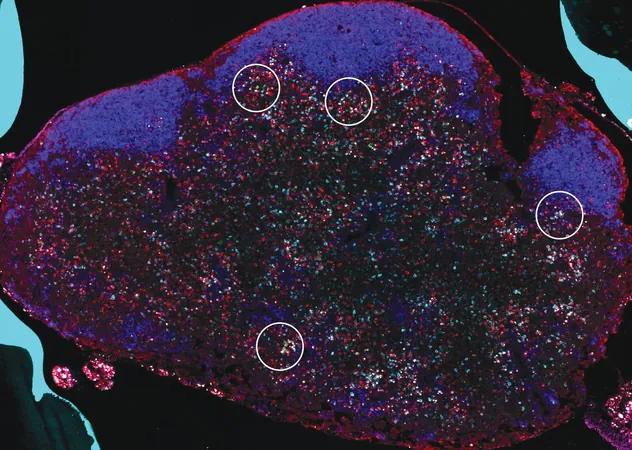
Breakthrough Research Uncovers How House Dust Mites Fuel Allergic Asthma Attack!
2024-11-18
Author: Mei
Groundbreaking Study on Allergic Asthma
In a groundbreaking study from the University of Pittsburgh, researchers have unveiled the intricate mechanisms by which inhaled house dust mites—ubiquitous triggers of allergic asthma—activate the immune system, leading to the development of this chronic condition in mouse models.
Published in Nature Immunology, this research sheds light on a critical issue: understanding how everyday allergens—like dust mites, pet dander, and pollen—can throw the immune system off balance, resulting in debilitating allergic reactions. These insights hold promise for advancing therapeutic strategies for managing allergic asthma.
Understanding Immune Tolerance
Dr. Amanda C. Poholek, the lead researcher and director of the Health Sciences Sequencing Core at Pitt's School of Medicine, emphasizes the complexity of the immune system that usually works tirelessly to distinguish between harmful pathogens and harmless environmental substances. "We often think of the immune system as an army that fights the bad guys," she explains. However, much of its activity is spent dealing with non-threats like dust and pollen.
The Role of T Helper 2 Cells
The critical concept here is "immune tolerance," which allows the immune system to ignore non-harmful irritants. When this tolerance is compromised, allergens can activate T Helper 2 (TH2) cells—a type of immune cell that triggers inflammation, exacerbating allergic asthma and other allergic diseases.
Allergic asthma, noted for symptoms such as coughing, wheezing, and shortness of breath, is on the rise globally, posing a significant challenge to healthcare systems. Understanding the exact triggers and pathways involved in this condition is pivotal for developing better treatments.
Innovative Mouse Model
To dive deeper into this phenomenon, Poholek’s team employed a mouse model that mimics human responses to inhaled allergens, unlike previous methodologies that utilized direct injections. Their state-of-the-art tools enabled precise tracking of TH2 cells to observe activation processes directly tied to inhaled house dust mites.
Molecular Mechanisms Uncovered
Their exploration revealed that a specific molecular pathway involving a crucial protein, BLIMP1, is necessary for TH2 cell development in the lymph nodes after exposure to house dust mites. Interestingly, this pathway was non-essential when house dust mites were injected directly, highlighting the critical role of natural exposure through the respiratory tract.
Further findings indicated the essential roles of two signaling proteins, IL2 and IL10, in driving the expression of BLIMP1. In a surprising twist, the typical anti-inflammatory cytokine IL10 was found to promote inflammation in this context, suggesting potential new avenues for therapy focusing on IL10—particularly crucial for newly diagnosed patients battling allergic asthma.
The Need for Innovative Therapies
Currently, most asthma patients rely on steroid treatments that alleviate symptoms but do not address the underlying causes of their condition. The urgent need for innovative therapies that can intervene early in the disease trajectory before irreversible airway damage occurs has never been more evident.
Discovering Hotspots in Lymph Nodes
Moreover, the researchers discovered distinct hotspots in the lymph nodes where IL2 activity was concentrated, contradicting prior assumptions that IL2 would be more evenly distributed throughout the lymph node. This discovery could lead to understanding how to disrupt these regions, aiming ultimately to halt the formation of TH2 cells and curb the onset of allergic asthma.
Looking Ahead
As research progresses, these exciting findings could pave the way for revolutionary treatment options that shift the focus from merely managing symptoms to truly tackling the root of allergic asthma. The journey from laboratory discovery to clinical application could offer hope to millions suffering from this prevalent condition.
Stay tuned as we continue to track the evolution of these promising developments in the fight against allergic asthma!



 Brasil (PT)
Brasil (PT)
 Canada (EN)
Canada (EN)
 Chile (ES)
Chile (ES)
 España (ES)
España (ES)
 France (FR)
France (FR)
 Hong Kong (EN)
Hong Kong (EN)
 Italia (IT)
Italia (IT)
 日本 (JA)
日本 (JA)
 Magyarország (HU)
Magyarország (HU)
 Norge (NO)
Norge (NO)
 Polska (PL)
Polska (PL)
 Schweiz (DE)
Schweiz (DE)
 Singapore (EN)
Singapore (EN)
 Sverige (SV)
Sverige (SV)
 Suomi (FI)
Suomi (FI)
 Türkiye (TR)
Türkiye (TR)